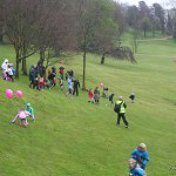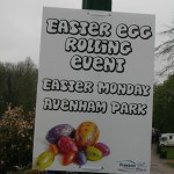Egg rolling is a traditional Easter event in Preston, with decorated hard-boiled eggs or, more commonly now, chocolate eggs rolled down the slopes of Avenham Park each year on Easter Monday.
Many thanks to calendarcustoms.com for allowing us to use their photos of the Avenham Park Egg Rolling event .
They also have a short video clip of the egg rolling in action which might be a nice start to this topic.
Activity 1: Egg rolling target
• Give each child an egg (hard-boiled or a variety of chocolate ones) and ask them to write their name on a sticker to put on their egg.
• Set a START line and a finish area either in the classroom or outside. The finish needs to be made from a line exactly 3m from the start and another line 10cm further back so there is a 10cm finish area.
• Children work in groups of 4-6 and take turns to roll their egg to get as close as they can to the finish area.
Maths Tasks
The group keeps a tally of how many times they rolled the egg ‘Too Hard’ if it went over the finish area, ‘Too soft’ if it didn’t reach the finish area or ‘Just right’ if they landed in the finish area.
KS1 The children then draw a pictogram to show the result.
KS 2 The children can display the results in various ways:
Pictograms with a full picture representing 5 or attempts and a half picture for between 1-4 attempts.
Pie charts showing the results as percentages or fractions
Frequencey Charts using the scale on a bar char to show the frequency the group rolled their egg 'Too hard', 'Too soft' or 'Just right'.
Activity 2 – Traditional Egg Rolling
• Give each child an egg (hard-boiled or a variety of chocolate ones) and ask them to write their name on a sticker to put on their egg.
• Set a START line either in the classroom or outside – grass is good and if you have a slope that works even better.
• Each child rolls their eggs as far as they can using an underarm action.
- Maths Tasks
KS1 - work in groups of 6. Use any object as a unit (a 30cm wooden rule or a book, for example) and measure the distance between the start line and each egg. Record the results in a table.
Children can display the results in a simple block graph or using interlocking cubes to show lengths. Ask: How far did …. roll his egg? How much further did …. roll her egg? What is the difference between the longest and shortest egg rolls?
KS2 - work in groups of 4-6. Measure the length of each egg roll accurately using a tape measure. Children can decide to measure in centimetres or metres and centimetres.
Draw a bar chart to show the results, children can decide the scale. Ask questions about the results: What is the difference between the longest and shortest egg rolls? What is the mean average roll? What is the range of the rolls?




